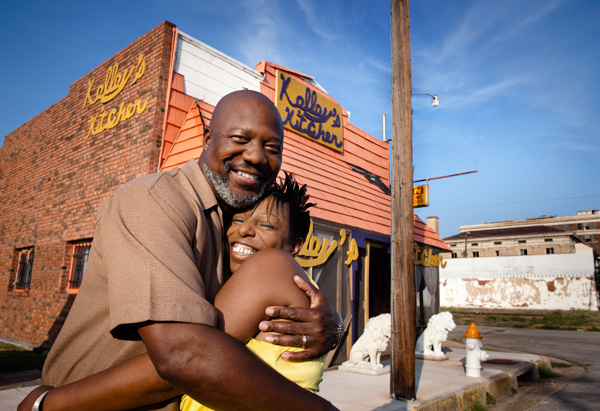The Avenging Angel: Hilton Kelley's Fight to Save His Hometown

Photo: Rob Howard
Hilton Kelley's restaurant and home were both flooded during Hurricane Harvey. He's in Port Arthur working with first responders, and documenting some of the devastation on Facebook. Our hearts are with him and everyone affected by the hurricane.
What do you do when your hometown is dying—wheezing in the shadow of massive oil refineries spewing poison through parks and playgrounds around the clock? If you're Hilton Kelley, you get angry. Then you get smart—raising your voice, raising money, and raising awareness as one of the most effective, exciting activists of your generation.
All alone on Austin Avenue, in downtown Port Arthur, Texas, Hilton Kelley is standing outside his empty restaurant between the two concrete lions he's got stationed at the door. Six feet two and 240 pounds, with a clean-shaven head, a wedge of gray scruff terminating at his chin, and a tendency to wear sunglasses at night, Kelley—at 51, one of the most important and accomplished environmental justice activists in the world today—possesses the air of a man who will not be intimidated.
The shingles on his slanted roof are the color of orange soda; a bunch were blown off during 2005's Hurricane Rita and have yet to be replaced. We pass through the restaurant's screened-in porch, with its purple trim and gauzy curtains. "Keeps the bugs out," says Kelley. "They're big down here. They bite." Inside, the 1,700-square-foot space has nine four-tops, each bearing a white plastic tablecloth and a battery-operated, vanilla-scented "candle." The upholstery on the chairs is Band-Aid hued. There's a plywood DJ booth near the door and a raised, balustraded dance floor that Kelley built himself in case anybody has the urge to swing out. More practically, Kelley opened this place so people on his side of town could gather, sit, and savor a home-style meal in a neighborhood lacking warmth and hospitality. Even though Kelley has a proper office nearby, he prefers to conduct his environmental and community work here—conference-calling with EPA offices in Washington and Dallas, and convincing kids to go back to school, all while Sade videos play on a constant loop.
"After Marie feeds you," says Kelley, "I'll drive you over to the fence line to show you some of our problems." Marie Kelley, Hilton's effervescent wife of nearly seven years, comes out of the kitchen smiling ear to ear, holding a large bowl brimming with gumbo. "Roux, ham, hen wings, chicken gizzards, sausage, and shrimp," she says, setting it on the table. "You're not one of these vegan activists, are you?" says Kelley, grinning. "I get a lot of vegans coming through here. It's okay if you are."
I'm not, but the fact is, Kelley's Kitchen, due to the decade-long advocacy of its proprietor, has become a critical refueling station on the small but powerful "Toxic Tours" environmentalists organize to bring burgeoning activists, deep-pocketed foundation members, and clueless politicians to the front lines of America's industrial pollution epidemic. Naturally, some of the green-minded don't eat meat—an act as radical in Southeast Texas as fighting the oil industry.
White twinkle lights are strung throughout the dining room in a way that's surely meant to bring some romance, some magic, to this desolate part of town, but unintentionally, they also mimic the strobes of the sprawling refinery visible through the window. It's just one more reminder that no matter where you go in Port Arthur, the oil is everywhere. Port Arthur, nearly a hundred miles east of Houston and about six from the Louisiana border, sits on America's chemical coast—a stretch of shoreline dominated by one of the highest concentrations of hazardous waste and petrochemical facilities and refineries in the country. The city itself has eight major ones within its limits. Dozens more plants are close by. Millions of pounds of toxic emissions float up into the air annually. The area between Port Arthur and neighboring cities Beaumont and Orange is called the Golden Triangle—from the air, the image of innumerable industrial flares can give the appearance of an epic triangular fire on the ground.



